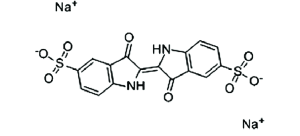What is E132, Indigotine ?
E132, also known as indigotine or indigo carmine, is a synthetic colorant commonly used in the food and pharmaceutical industries. It imparts a vibrant blue hue to various products, making it a popular choice for coloring applications.
Derived from coal tar, E132 belongs to the indigoid family of colorants. Its molecular formula is C16H8N2Na2O8S2, and it exhibits high solubility in water.

Approved Usage and Recommended Daily Intake
The European Food Safety Authority (EFSA) has approved E132 as a food additive under the E number system. Similar approvals exist in many other countries. However, strict regulations govern its use to ensure consumer safety.
The recommended daily intake for human consumption is up to 5 mg/kg body weight per day.
Products containing E132 must clearly list it on the label, allowing consumers to make informed choices, especially those who may have sensitivities or allergies to artificial dyes.
Read also – E131 – Patent Blue V
Applications of E132
E132 finds diverse applications in various industries :
- Food Industry: Widely used to color candies, beverages, and desserts, particularly in sweets and ice cream, where a bright blue color is desired.
- Pharmaceuticals: Employed to color tablets and capsules, aiding product identification and enhancing aesthetic appeal.
- Medical Diagnostics: Used as a diagnostic tool in medical procedures, such as highlighting structures in the urinary system during urological surgeries.
- Cosmetics and Personal Care: Found in some cosmetics like shampoos and bath gels, providing a vibrant blue color.
Potential Risks and Contraindications
While generally considered safe, some studies raise concerns about potential allergic reactions in sensitive individuals. Severe allergic reactions, especially in those with a history of allergies to synthetic colorants, can occur in rare cases.
Being an iodine-based compound, it may cause thyroid gland disorders.
Limiting daily intake is recommended. Careful reading of food labels is advised.
It is not permitted in infant and young children’s food.
Read also – A new sweetener has been approved by the European Union
Limiting E132 Intake and Natural Alternatives
Due to concerns about synthetic colorants, there is a growing interest in natural alternatives. Options to E132 include plant-based extracts like spirulina and butterfly pea flower, which provide a similar blue hue without synthetic components. These natural options are gaining popularity, particularly in the organic food market.
Consumers are becoming increasingly aware of potential health and environmental impacts of food additives. This is driving a demand for cleaner labels and the use of natural ingredients. Look for products with cleaner labels or those using natural additives. By installing the InfoCons Application and scanning the barcodes of food products, you can find the number and type of food additives in the application.
As regulations and consumer preferences evolve, the food and pharmaceutical coloring industry is likely to continue adapting. This may involve developing safer synthetic colorants, exploring natural alternatives, and refining production processes to minimize environmental impact.
In conclusion, E132, indigotine, plays a significant role in various industries due to its vibrant color and versatility. While generally safe for use within regulated limits, consumers and manufacturers are becoming increasingly aware of potential health and environmental concerns. As the landscape of consumer preferences and regulations continues to evolve, the food and pharmaceutical coloring industry will need to adapt to meet these changing demands.
Author – Cosmina Nițu
Master in Nutrition – Infant and new born nutrition
www.efsa.europa.eu
https://efsa.onlinelibrary.wiley.com/
https://www.researchgate.net/